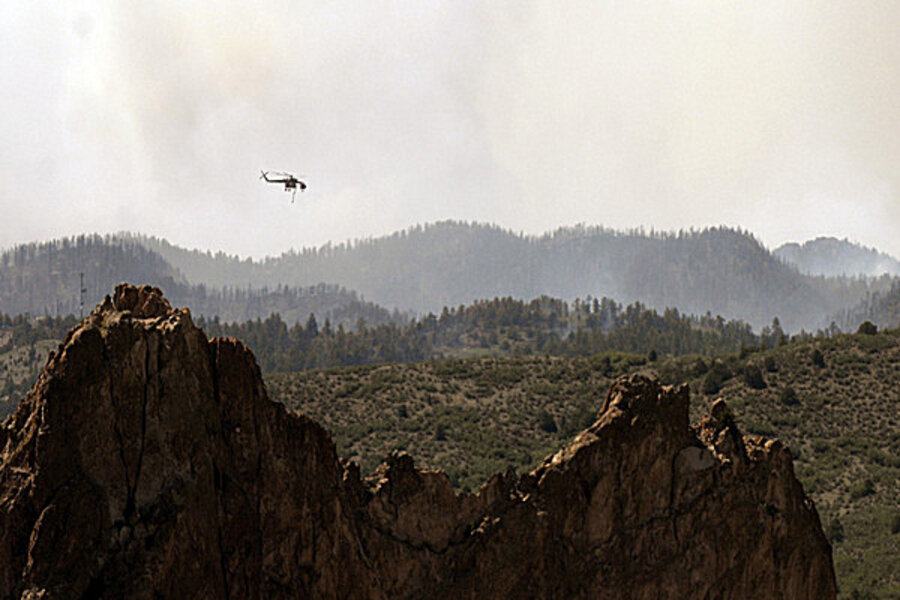Fighting Western wildfires: Does Forest Service have enough air power?
Loading...
| Los Angeles
As large fires scorch vast tracts of land from Alaska to Colorado and Arkansas, the debate over the nation’s fire-fighting preparedness is also heating up.
The air tanker fleet tasked with the most dangerous mega-fire tasks – think dropping tons of fire-retardant into remote and steep canyons – is under particular scrutiny. Pointing to the fleet’s decade-long decline from some 44 tankers in 2002 to nine at the start of the 2012 fire season, one critic is calling the current situation an “air tanker crisis.”
However Tom Tidwell, chief of the US Forest Service, one of four federal agencies charged with tackling fires and the one responsible for deploying the air tankers anywhere in the country, maintains that the state of preparedness is good, because the air tankers are only part of the overall mix of fire-fighting resources.
Mr. Tidwell points to some 300 helicopters and small planes that are also used, noting that in the past decade, the mix has shifted, with more emphasis on the smaller craft. As a former firefighter, Tidwell says, “the personnel on the ground really appreciate the helicopters because they can go places the large planes cannot.”
Nonetheless, he notes that over the weekend, the service sealed a deal with the US military to deliver four tankers when needed. In addition, the Forest Service has assembled eight other plane contracts, including several with the Canadian government to bring the available tankers for this season to 21. Beyond that, he points to additional resources that have just been announced – a contract for seven total next-generation air tankers, three to be delivered by the end of this year.
But those numbers don’t tell the whole story – and they are too little, too late, says former wildland firefighter Bill Gabbert, founder of WildfireToday.com, a fire news blog. He points to numerous fatal crashes, two this year, attributable in part to aircraft age and metal fatigue.
“Eight of the nine planes in the core fleet today date back to the Korean War era,” he points out, adding, “We are in a crisis.”
Tidwell suggests there is too much emphasis on the role of the air tanker in fire suppression, adding, “there is this perception that tankers put out fires. But they don’t. Firefighters put out fires.”
However, notes Mr. Gabbert, the large tankers play a critical role in the initial attack on fires. “If we had more tankers, we could avoid the tens of millions of dollars spent when small fires don’t get put out and they turn into mega-fires,” he says.
A complex mix of changing weather patterns and human behavior means that the need for a more robust air-tanker response is not a temporary or merely seasonal spike, says William Sommers, a 30-year US Forest Service veteran who also served as its director of Forest Fire and Atmospheric Sciences Research.
Tactical aircraft can be used to help protect particular resources at risk, he notes, adding via e-mail, however, that “the current fleet of aging aircraft is woefully inadequate in the face of increased climate- and fuels-driven fire regimes being experienced in many places around the globe – including the interior West of the US.”
The current severe fire situation is just another instance in a building trend driven by large-scale climate change, fuel buildup from years of fire suppressions, and drought, as well as increased home-building in previously wild areas, he notes.
“The only question from year to year is what particular area is going to be hardest hit and when will that occur,” he adds.
Dominik Kulakowski, assistant professor of geography and biology at Clark University in Worcester, Mass., says that while resources may be adequate for fighting fires during more moderate climatic conditions, “they are insufficient for fighting fires during droughts that are as extreme as those we have been seeing in recent years.”
More tankers and other resources would certainly be helpful for fighting fires, but given the enormous area of forests in the Western US that could potentially burn, he says, “we should be thinking not only about how to extinguish fires after they start, but also how to address the underlying climatic conditions that are making these mega-fires possible.”
Lamont Norman, wildfire risk expert at Pitney Bowes Software, points out that this year is bringing the issue home because there is a significant additional wildfire risk caused by a large number of dead pine trees.
Western foresters are managing over 41 million acres of dead trees caused by the Mountain Pine Beetle infestation, he notes, adding via e-mail, “one of the reasons for this infestation is that years of wildfire suppression has caused growth of dense tree stands with weaker trees that cannot fight off the beetle.”
“The massive tree kill and dead tree density has turned Western wildfires into potential big fire events that can burn for weeks.”







